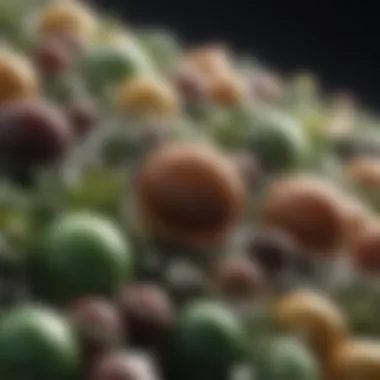Exploring Oligo Sequences: Significance in Science


Intro
In the field of molecular biology, the exploration of oligo sequences has become increasingly crucial. This article presents a comprehensive overview of oligos, which are short strands of nucleotides, integral to various genetic research and applications. Understanding these sequences offers insight into their diverse roles in diagnostics and therapeutics.
Oligo sequences vary in length and structure, consisting mainly of DNA or RNA segments. Their significance cannot be understated, as they serve as essential tools for scientists, researchers, and educators. As we delve deeper into the topic, we will highlight the key points relevant to oligo sequences while ensuring clarity and depth.
Research Overview
The investigation of oligo sequences reveals several significant findings that are relevant to both genetic research and practical applications. This section summarizes the key findings and the methodologies employed to conduct such research.
Summary of Key Findings
- Oligo sequences facilitate the study of genetic disorders by allowing precise targeting and analysis of specific genes.
- Various types of oligos, including antisense oligonucleotides and siRNAs, play diverse roles in gene expression modulation.
- The synthesis of oligo sequences has evolved, leading to improved yield and purity, which enhances their applications in research.
- Oligo sequences have shown substantial promise in therapeutic developments, especially in personalized medicine.
Methodologies Employed
Several methodologies are implemented in conducting research related to oligo sequences. These may include:
- Synthesis Techniques: Solid-phase synthesis is a commonly used method for oligo production, allowing for controlled assembly at specific sequences.
- Analytical Techniques: High-performance liquid chromatography (HPLC) is employed to assess the purity and quality of synthesized oligos, ensuring reliable results in experiments.
- Sequencing Technologies: Next-generation sequencing (NGS) has revolutionized the ability to analyze and compare oligo sequences effectively.
In-Depth Analysis
Understanding the implications of the research surrounding oligo sequences necessitates a detailed examination of results and comparisons with previous studies.
Detailed Examination of Results
Recent studies have shown that oligos can modulate gene expression effectively. This modulation is achieved through mechanisms such as RNA interference (RNAi), where small interfering RNA sequences lead to the degradation of target mRNA, inhibiting gene expression. Such advancements emphasize the utility of oligos in therapeutic contexts.
Comparison with Previous Studies
While many studies have explored the capabilities of oligo sequences, recent advancements have distinguished newer methodologies that enhance efficiency and accuracy. Comparative analysis with older results indicates clear progress in synthesis efficiency and application breadth. The improved designs of oligos, like those containing modified nucleotides, showcase enhanced stability and longer retention in biological systems, thereby increasing efficacy in therapeutic applications.
Ultimately, this overview underscores the pivotal role of oligo sequences in both research and practical uses, highlighting their importance in advancing scientific discoveries and addressing genetic disorders.
Prolusion to Oligo Sequences
Oligo sequences play a crucial role in molecular biology and genetic research. Understanding these sequences is fundamental for students, researchers, educators, and professionals in the field. Oligonucleotides, often referred to as oligos, serve as the building blocks for various biological functions and are essential in numerous applications within the scientific community. Their significance stretches across diagnostics, therapeutics, and research advancements.
In this section, we will explore the definition and characteristics of oligo sequences, as well as their historical context. Grasping these foundational elements will provide a clearer picture of how oligos function in modern molecular biology and their contribution to understanding complex genetic phenomena.
Definition and Characteristics
Oligo sequences are short sequences of nucleotides, typically ranging from 2 to 100 bases in length. These sequences can be composed of DNA, RNA, or modified nucleotides. One critical characteristic of oligos is their specificity; they can be designed to bind to complementary sequences, which makes them valuable tools in techniques like polymerase chain reaction (PCR) and in situ hybridization.
The unique properties of oligos include:
- Hybridization Ability: Oligos can easily bind to complementary strands. This property is crucial for various applications including gene detection and expression analysis.
- Chemical Stability: The stability of an oligo can greatly influence its effectiveness in experiments. Chemical modifications can enhance this stability, making oligos more viable in different environments.
- Versatility: Oligos can be tailored for specific purposes, whether for research, diagnostics, or therapeutic interventions. Their adaptable nature allows them to meet the diverse needs of molecular biology.
In summary, the definition and characteristics of oligo sequences establish a basis for understanding their utility and relevance in scientific research and application.
Historical Context
The history of oligo sequences traces back to the early developments in molecular biology. Initially, the study of nucleic acids began with the discovery of DNA and RNA structures in the mid-20th century. It was during this time that scientists recognized the potential of manipulating these sequences for various applications.
The advanced techniques of oligonucleotide synthesis emerged in the 1980s, significantly changing the landscape of genetic research. The introduction of solid-phase synthesis allowed researchers to create DNA and RNA strands with greater precision. This innovation led to a surge in the use of oligos in biotechnology, diagnostics, and therapeutics.
Important milestones in the history of oligo sequences include:
- 1970s: The advent of methods to sequence DNA paved the way for the development of oligonucleotide synthesis.
- 1980s: The introduction of automated synthesizers revolutionized the production of oligos, making them more accessible for widespread use.
- 1990s and Beyond: The incorporation of oligonucleotides in therapeutic applications, such as antisense therapy and RNA interference, has further solidified their importance in modern medicine.
Understanding the historical context of oligo sequences illuminates their evolution and foundational role in shaping current molecular biology practices. This context is imperative for appreciating the significance of oligos in contemporary research and their future potential in the field.


Types of Oligo Sequences
Understanding the different types of oligo sequences is crucial, as each type has distinct characteristics and applications. This section will discuss DNA oligonucleotides, RNA oligonucleotides, and modified oligonucleotides—highlighting their significance in research and therapeutic development.
DNA Oligonucleotides
DNA oligonucleotides are short strands of nucleic acids, typically 20 to 30 bases long. They are essential tools in molecular biology and have a wide range of applications, from cloning to PCR amplification. The design of DNA oligonucleotides can be custom-tailored for specific uses, making them versatile in research.
Some key applications include:
- Primers: Used in PCR to amplify DNA sequences.
- Probes: In hybridization techniques to detect specific DNA sequences.
- Gene Synthesis: Used in the assembly of synthetic genes.
Their stability and specificity make DNA oligonucleotides indispensable in genetic research. However, careful design is essential to minimize the chances of secondary structures that could interfere with performance.
RNA Oligonucleotides
RNA oligonucleotides play a critical role in gene expression and regulation. They are often used in studies involving mRNA and are vital in RNA interference (RNAi) technology. RNA oligonucleotides can be designed as small interfering RNAs (siRNAs) or antisense oligonucleotides (ASOs).
The applications of RNA oligonucleotides include:
- Gene Silencing: siRNAs can reduce gene expression by promoting the degradation of specific mRNA.
- Therapeutics: ASOs are used to modify splicing or correct genetic mutations.
- Diagnostics: Detection of viral RNA in clinical samples.
RNA oligonucleotides are sensitive to degradation by nucleases, which is a significant consideration during their handling and application. Their use in therapeutic settings is growing, but challenges remain regarding delivery and stability.
Modified Oligonucleotides
Modified oligonucleotides include synthetic sequences that have been chemically altered to enhance performance. These modifications can improve stability, binding affinity, and reduce immunogenicity. Common modifications include phosphorothioate linkages, locked nucleic acids (LNAs), and 2'-O-methyl ribonucleotides.
Key advantages of modified oligonucleotides are:
- Enhanced Stability: More resistant to enzymatic degradation.
- Improved Target Affinity: Often leads to better hybridization with complementary sequences.
- Reduced Immunogenicity: Important in therapeutic development.
Some uses of modified oligonucleotides encompass therapeutic agents, diagnostic probes, and molecular tools that require high precision. Their versatility has expanded their application across various fields, including oncology and infectious diseases.
"The advancement of oligonucleotide technology is reshaping our approach to diseases, offering innovative treatment paths that were once considered unattainable."
In summary, understanding the different types of oligo sequences is fundamental for anyone in the molecular biology field. Each type possesses unique features that facilitate various applications, from research to clinical applications.
Synthesis of Oligo Sequences
The synthesis of oligo sequences is a critical aspect of molecular biology. This process enables the creation of short DNA or RNA fragments that play essential roles in various biological functions and research applications. Understanding the methods of synthesis provides insight into how researchers manipulate genetic material for diagnostics, therapeutics, and developmental studies. The significance lies not only in the products generated but also in the advancements in technology that enhance the efficiency and precision of synthesis.
The choice of synthesis method can influence the purity, yield, and functionality of the oligonucleotides produced. Therefore, exploring the various techniques is vital for any scientist or student interested in the field. Different methods come with their own set of advantages and drawbacks, requiring careful consideration depending on the intended application.
Solid-Phase Synthesis
Solid-phase synthesis is a widely utilized method in the production of oligonucleotides. This process involves attaching the growing oligonucleotide chain to a solid support, often a resin. During synthesis, nucleotides are sequentially added to the chain, and each step is followed by removal of protective groups. This approach allows for high precision and enables the synthesis of long oligonucleotides with a high degree of purity.
The advantages of solid-phase synthesis include:
- High automation potential
- Scalability for large production
- Capability of creating modified nucleotides
However, the technique is not without its challenges. Issues such as incomplete reactions and side product formation can occur, leading to lower yields. Therefore, continuous optimization of reaction conditions is necessary.
Liquid-Phase Synthesis
Liquid-phase synthesis, on the other hand, involves oligonucleotides being formed in a solution rather than on a solid support. This method is not as common as solid-phase synthesis but offers certain unique benefits. One of the main advantages of liquid-phase synthesis is flexibility. It allows for easier reaction control and is particularly useful when synthesizing small oligonucleotides.
However, liquid-phase synthesis has limitations. The purification process can be more complicated, potentially requiring additional steps to ensure purity and specificity. This method is often used when the synthesis of high-quality, short oligonucleotides is necessary, particularly in specialized research areas.
Enzymatic Synthesis
Enzymatic synthesis represents a more biologically integrated approach. This method utilizes specific enzymes, such as DNA polymerases, to aid in the construction of oligonucleotides. It mimics natural processes, allowing for the replication and synthesis of nucleic acids through enzymatic pathways.


Advantages of enzymatic synthesis include:
- High fidelity of nucleotide incorporation
- Ability to synthesize complex sequences
Despite its benefits, enzymatic synthesis can be sensitive to conditions such as temperature and pH. Additionally, the scale of production may be limited compared to chemical methods.
Applications of Oligo Sequences
The applications of oligo sequences play a pivotal role in both fundamental and applied molecular biology. They have transformed various disciplines, including diagnostics, therapeutics, and scientific research. Understanding their application is essential for grasping their importance in advancing medical and biological knowledge. Throughout this section, we address significant elements, benefits, and considerations regarding the applications of oligo sequences, particularly how they influence contemporary scientific practices.
Diagnostic Applications
Oligo sequences are invaluable tools in the diagnostic field. They are utilized in numerous assays, including polymerase chain reaction (PCR), which amplifies specific DNA sequences. This amplification capability allows for detection of genetic material from pathogens, enabling rapid diagnosis of infectious diseases. Oligonucleotides can also be used in techniques like reverse transcription PCR (RT-PCR) for RNA analysis, aiding in the detection of viruses such as SARS-CoV-2.
Using oligo sequences for diagnostics has a few key benefits:
- Specificity: Oligo sequences can be designed to bind specifically to target sequences, ensuring accurate results.
- Sensitivity: They enhance sensitivity, allowing for the detection of low-abundance targets.
- Speed: Time-efficient, they facilitate rapid testing processes, a crucial factor during outbreaks.
However, some considerations must be addressed. The design of oligo sequences requires careful optimization to avoid complications such as non-specific binding or mispriming, which can lead to false results. Also, the quality and integrity of oligo sequences must be monitored to ensure reliable diagnostic applications.
Therapeutic Applications
In therapy, oligo sequences are emerging as a groundbreaking approach to treat genetic disorders. They function by targeting specific genetic sequences involved in diseases, offering tailored treatment options. Antisense oligonucleotides, for example, can modulate gene expression by preventing the translation of defective RNA. This helps counteract diseases caused by mutations.
Some therapeutic applications include:
- Gene Silencing: Antisense oligonucleotides can inhibit the production of harmful proteins, offering potential treatments for conditions like Duchenne Muscular Dystrophy.
- Gene Editing: Oligo sequences can provide templates for gene correction through CRISPR methodologies, promoting precision medicine.
- Cancer Therapy: Modified oligonucleotides are being investigated to target cancer cells specifically, reducing damage to normal cells.
Despite the promising applications, there are important factors to consider. The delivery of therapeutic oligonucleotides remains a challenge. Effective methods are still in development to improve cellular uptake while minimizing degradation. Additionally, the potential for off-target effects must be evaluated thoroughly for the safety of treatments.
Research and Development
In research, oligo sequences are central to many experimental designs and methodologies. They serve as essential tools for genetic analysis, enabling researchers to probe into genetic functions and regulatory elements. Their use in high-throughput sequencing technologies accelerates advancements in genomics, allowing for a deeper understanding of genes and their interactions.
Benefits of applying oligo sequences in research include:
- Customization: Oligonucleotides can be tailored for specific research purposes, enabling targeted investigations.
- Cost-effectiveness: They typically do not require expensive reagents, reducing overall research costs.
- Scalability: Oligonucleotides are compatible with large-scale applications, facilitating the study of complex biological systems.
When conducting research, careful design of oligo sequences is critical to mitigate risks of unintended results. Rigor in experimental validation is necessary for ensuring that outcomes are reproducible and reliable. Furthermore, the integration of innovative platforms will be essential in expanding the capabilities of oligo sequences in research and development.
"The evolution of oligo sequences represents a significant shift in how we approach biological research and therapeutic development."
Role of Oligo Sequences in Genetic Disorders
Oligo sequences have an indispensable role in understanding and addressing genetic disorders. These short strands of nucleotides are essential tools in molecular biology, particularly for research involving DNA and RNA. By facilitating precise manipulation of genetic material, oligo sequences help in the exploration of various genetic mutations, which can lead to significant advancements in diagnostics and therapeutics. This section will highlight how oligos are utilized in genetic research, their role in identifying mutations, and exploring potential treatments for genetic disorders.
Understanding Genetic Mutations
Genetic mutations can be subtle or substantial alterations in the DNA sequence. These mutations may lead to various disorders ranging from mild to severe. The relationship between oligo sequences and genetic mutations is pivotal. By designing specific oligonucleotides, researchers can target and amplify particular regions of DNA. This targeted approach enables the identification of mutations with high specificity.
Key points related to this subject include:
- Mutation Identification: Oligonucleotides can hybridize to mutated regions, allowing for the detection of single-nucleotide polymorphisms (SNPs) and more complex mutations.
- Sequencing Applications: In next-generation sequencing, oligos are crucial for creating libraries that provide insights into mutational landscapes.
- SNP Genotyping: Specific oligo sequences are used to differentiate between normal and mutant alleles, which is vital in personalized medicine.
Understanding how oligo sequences interact with genetic mutations helps illuminate pathways toward diagnosing hereditary conditions. This insight is invaluable for researchers and healthcare professionals.
Oligonucleotides serve as primers in PCR amplification, enabling detailed study of genetic disorders. This method has accelerated the pace of research significantly.
Therapeutic Solutions for Genetic Disorders
The therapeutic potential of oligo sequences is vast. Therapeutics that target specific genetic mutations can offer innovative solutions for conditions previously thought to be untreatable. Oligonucleotide-based therapies, including gene editing and RNA interference, have gained traction in recent years. Treatments like antisense oligonucleotides can modify gene expression to address specific mutations.
Here are some therapeutic strategies encapsulated with the use of oligos:


- Gene Silencing: Antisense oligonucleotides can inhibit the expression of malfunctioning genes, proven effective in some neuromuscular disorders.
- CRISPR Modifications: Oligos can facilitate CRISPR technology to edit genes precisely, opening doors to potential cures for genetic disorders.
- Exon Skipping: This innovative approach uses oligonucleotides to skip faulty exons in pre-mRNA, restoring the function of mutated genes.
Oligo sequences thus represent a linchpin in therapeutic methodologies for genetic disorders. By directly targeting genetic issues, they bridge the gap between basic research and clinical application, holding promise for significant future advancements.
Future Directions in Oligo Sequence Research
Oligo sequences are poised on the edge of remarkable advancements in various fields, particularly in biotechnology and genetic medicine. This section explores several future directions in oligo sequence research, aiming to pinpoint the significance and potential of ongoing investigations in this domain. The exploration encompasses the latest innovations in therapeutic applications, enhancements in synthesis methods, and considerations surrounding ethical practices and regulations.
Innovations in Oligonucleotide Therapeutics
The evolution of oligonucleotide therapeutics represents one of the most promising areas of research. Innovations such as RNA interference (RNAi) and antisense oligonucleotides (ASOs) continue to show great potential in treating genetic disorders. Developing more efficient delivery systems is vital to ensure that these therapeutic modalities reach their intended targets within cells effectively.
Current research focuses on developing modified oligonucleotides that exhibit enhanced stability and increased efficacy. For instance, locked nucleic acids (LNAs) and morpholino oligonucleotides (MOs) have been introduced to improve binding affinity and reduce off-target effects. A noteworthy benefit of these innovations is their ability to address previously undruggable targets, opening new therapeutic pathways for challenging diseases.
"The advent of oligonucleotide therapeutics could radically alter the landscape of treatments for genetic disorders and cancers."
Advancements in Synthesis Techniques
As the demand for oligonucleotides escalates, the synthesis techniques will need to advance accordingly. New methodologies such as microfluidics and DNA assembly technologies are revolutionizing how oligonucleotides are synthesized. These advancements not only increase the scale of production but also enhance the precision and speed of the synthesis process.
For example, microfluidic devices can control droplets containing oligonucleotide building blocks, allowing for high-throughput synthesis and minimizing waste. Such techniques have the potential to reduce costs and improve the accessibility of oligonucleotide-based therapies. Future developments may include the integration of artificial intelligence to optimize synthesis parameters and streamline the design process, ensuring efficiency.
Ethics and Regulations
With the rapid progress in oligo sequence research, it brings forth significant ethical considerations and regulatory challenges. As oligonucleotide therapies become more mainstream, establishing comprehensive guidelines is crucial. These regulations should address safety concerns, including off-target effects and long-term impacts on human health.
Additionally, ethical considerations related to genetic manipulation and access to these therapies are growing in importance. The disparities in access to cutting-edge treatments must be acknowledged, ensuring equitable distribution across different populations. Future research must encompass these ethical dimensions, promoting responsible advancements in this field.
Challenges and Limitations in Oligo Sequence Application
The application of oligo sequences in molecular biology carries various challenges that necessitate thorough examination. Understanding these limitations is vital for researchers, educators, and students alike, as they navigate the complexities of this field. Addressing these challenges not only enhances the development of more effective oligonucleotide strategies but also paves the way for innovative research applications.
Stability and Degradation
Stability of oligo sequences is paramount for their effectiveness in scientific applications. Oligonucleotides can be prone to degradation through environmental factors such as temperature, pH, and presence of nucleases. This degradation can limit the lifespan and effectiveness of oligonucleotide therapies.
Factors contributing to stability include:
- Chemical Structure: Modification of nucleotides can significantly enhance stability. Phosphorothioate and locked nucleic acid (LNA) are examples of modified oligonucleotides showing improved resistance to degradation.
- Storage Conditions: Proper storage is essential. Maintaining a low temperature and inert atmosphere can help prolong oligonucleotide integrity.
- Concentration: At higher concentrations, oligos are more susceptible to self-hybridization and aggregation, which can complicate their delivery and function.
"Understanding stability mechanisms provides essential insights for improving oligonucleotide therapeutics."
To mitigate degradation, researchers are exploring new formulations and delivery techniques, ensuring that oligonucleotides retain their functionality over time.
Delivery Mechanisms
The efficiency of oligo sequences is also highly dependent on delivery mechanisms. Effective delivery ensures that therapeutic oligonucleotides reach their intended target cells and tissues. Challenges arise in the following areas:
- Cell Membrane Penetration: Natural oligonucleotides struggle to penetrate cell membranes due to their hydrophilic nature. Thus, various strategies, such as liposomes or nanoparticles, are being developed to facilitate entry into cells.
- Target Specificity: Developing targeting ligands is essential to ensure that oligonucleotides are delivered to specific tissues or cell types. This selectivity is crucial in therapeutic applications to minimize off-target effects.
- Release Profiles: Once delivered, oligonucleotides need to be released in a controlled manner. Delivery systems must ensure that the oligonucleotides remain intact during transit but are released in an active form once inside the target cells.
The interplay of these factors can greatly influence the success of oligonucleotide therapies and applications. Scientists are now increasingly focused on optimizing delivery systems to enhance the specificity and efficacy of oligo sequence utilization.
Culmination
The conclusion serves as a critical reflection on the importance of oligo sequences in various scientific fields. It synthesizes the significant information presented throughout the article, highlighting how oligo sequences impact diagnostics, therapeutics, and research. Furthermore, it emphasizes the relevance of understanding oligo sequences not only for academic pursuits but also for real-world applications in medicine and biotechnology.
Oligo sequences are invaluable tools that allow researchers to manipulate genetic material with precision. Their role in developing diagnostic techniques is profound. They enable the detection of specific genetic mutations and pathogens, aiding in the timely diagnosis of various diseases. In therapeutics, oligo sequences are at the forefront of innovations such as antisense therapy and gene editing, which hold the potential to transform treatment paradigms for genetic disorders and cancers.
Importantly, as the field evolves, the challenges associated with oligo synthesis and application also demand attention. Awareness of their limitations regarding stability and delivery mechanisms raises considerations on how to optimize these sequences for better efficacy. Overall, this conclusion reiterates the need for continued exploration and understanding of oligo sequences, as they remain central to advancements in molecular biology.
Summary of Key Points
- Oligo sequences are crucial in molecular biology and genetic engineering.
- They play essential roles in diagnostics by facilitating the identification of genetic disorders, pathogens, and mutations.
- The therapeutic applications of oligo sequences continue to expand, offering potential solutions to previously untreatable conditions.
- Challenges such as oligo sequence stability and efficient delivery methods must be addressed for effective implementation in clinical settings.
- Future research is necessary to unlock the full potential of oligo sequences, ensuring their systematic integration into therapeutic strategies.
Implications for Future Research
The implications for future research in oligo sequences are significant. As biotechnology advances, the need for more effective oligonucleotide treatments will likely increase, calling for enhanced synthesis methods. New approaches in solid-phase and enzymatic synthesis may yield higher purity and yield, creating sequences that are more effective in their roles.
Moreover, the ethical considerations surrounding the use of oligo sequences, particularly in gene editing, underscore a need for rigorous guidelines and regulations. Ensuring safety and efficacy in clinical trials will be paramount. Collaboration between researchers, ethicists, and regulators will pave the way for responsible use of these powerful tools.
In summary, as the understanding of oligo sequences evolves, so does the responsibility to leverage their potential for the betterment of healthcare and scientific exploration.















